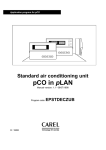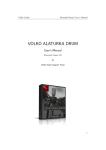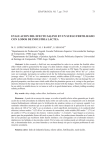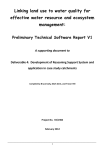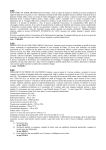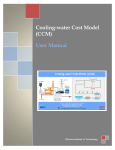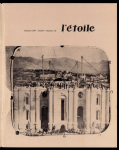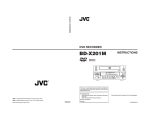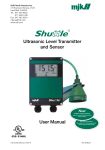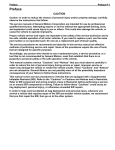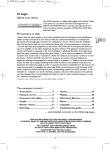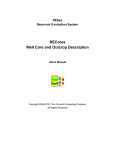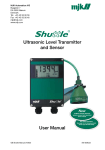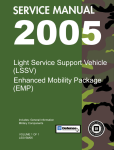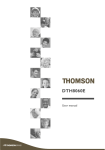Download CEMC Report No. 200702
Transcript
Modelling the Fate of Contaminants Introduced into Agricultural Soils from Biosolids BASL4 Model: Users' Manual CEMC Report No. 200702 Prepared by: Eva Webster and Don Mackay Canadian Environmental Modelling Centre Trent University Peterborough, Ontario K9J 7B8 CANADA Modelling the Fate of Contaminants Introduced into Agricultural Soils from Biosolids Report to Environment Canada BASL4 Model: Users’ Manual April 27, 2007 Prepared by: Eva Webster and Don Mackay Carrousel Computing Peterborough, Ontario K9J 6Y1 EC Departmental Representatives: Scientific Authority: Ken Taylor, Senior Evaluator Assessment Section, Existing Substances Division Contract Authority: Robert Chénier, Chief Assessment Section, Existing Substances Division Environment Canada Place Vincent Massey, 20th Floor 351 St. Joseph Blvd. Gatineau, Quebec K1A 0H3 TABLE OF CONTENTS TABLE OF CONTENTS ......................................................................................................................... EXECUTIVE SUMMARY ....................................................................................................................... 1. INTRODUCTION............................................................................................................................. 1 1.1 Background ........................................................................................................................... 1 1.2 Objectives ............................................................................................................................. 2 2. THE FUGACITY CONCEPT ............................................................................................................. 2 2.1 Concentration and Fugacity .................................................................................................. 2 2.2 Z values................................................................................................................................. 3 2.3 Transfer and Loss Processes in Soil: D values and Fluxes................................................... 6 2.4 Dynamic Soil Calculations ................................................................................................... 9 2.5 Uptake by Biota .................................................................................................................. 11 2.5.1 Equilibrium .................................................................................................................. 12 2.5.2 Non-Equilibrium Uptake and Loss Processes.............................................................. 12 Invertebrate....................................................................................................................... 12 Mammal ............................................................................................................................ 15 2.5.3 Steady-state .................................................................................................................. 18 2.5.4 Dynamic....................................................................................................................... 18 Carrot Root ....................................................................................................................... 18 Invertebrate and Mammal................................................................................................. 20 3. GETTING STARTED ..................................................................................................................... 21 3.1 System Requirements.......................................................................................................... 21 3.2 How to Obtain Program Copies.......................................................................................... 20 3.3 Installation........................................................................................................................... 21 3.4 Program Navigation ............................................................................................................21 4. MODEL DESCRIPTION ................................................................................................................. 22 4.1 Model Overview ................................................................................................................. 22 4.2 Intended Uses...................................................................................................................... 22 4.3 Model Design...................................................................................................................... 23 4.4 Model Inputs ....................................................................................................................... 24 4.4.1 Chemical Properties ..................................................................................................... 24 Adding a Chemical............................................................................................................ 26 4.4.2 Soil Properties.............................................................................................................. 26 Adding a Soil..................................................................................................................... 26 Bioavailability Factor....................................................................................................... 28 4.4.3 Biota Properties............................................................................................................ 29 4.5 Simulation Conditions ........................................................................................................ 32 4.5.1 Simulation Times ......................................................................................................... 32 4.5.2 Application Events....................................................................................................... 33 4.5.3 Ploughing Events ......................................................................................................... 34 4.6 Model Calculations ............................................................................................................. 34 4.7 Model Results - Parameters ................................................................................................ 34 4.8 Model Results - Chemical Fate........................................................................................... 39 4.8.1 Fate in Soil ................................................................................................................... 39 4.8.2 Fate in Biota................................................................................................................. 43 5. UNDERSTANDING THE RESULTS ................................................................................................. 47 5.1 Sample Analysis.................................................................................................................. 47 5.2 Sensitivity and Uncertainty................................................................................................. 49 REFERENCES AND SOURCES ........................................................................................................... 50 Appendix A: The Software License Agreement........................................................................... 53 EXECUTIVE SUMMARY The BASL4 model has been designed to make operation as intuitive as possible to operate. This manual is intended to provide additional information that may be less obvious. It is intended to assist the novice model-user in understanding when, why, and how to use the BASL4 model of chemical fate in a two-layer agricultural soil. Instructions are given on software installation. The science behind the model is briefly described. The model layout is described and instructions are given on running the model. Assistance is given with understanding the model results. The model uses physical chemical property data and concentrations in biosolids to calculate the concentrations in soil and uptake into vegetation, soil invertebrates and soil-dwelling mammals. The soil component of the model allows different two-layer soils to be defined and stored by the user. Soil properties include soil depths, organic carbon and water content, leaching and bioturbation rates, and the degradation rate of organic matter in the soil. Each layer is treated as a single well-mixed, or homogeneous, medium. The user can define up to three applications of biosolids and ploughing events. For each biosolid application, the volume fraction of organic carbon are required from the user. While the model is designed to treat a single growing season, estimates of long-term chemical fate can be obtained but must be interpeted with some caution due primarily to the effect of variations in temperature that are not treated by this model. The vegetation, invertebrates and soil-dwelling mammals are modelled using three levels of simplifying assumptions, namely equilibrium, steady-state, and non-steady-state (i.e., dynamic). With an understanding of a chemical’s fate in the soil, vegetation, and soil-dwelling organisms, higher-order systems such as a terrestrial food web including biomagnification through to top predators may be considered. The BASL4 model is stand-alone software with calculations viewable, but not modifiable, by the user. This ensures that all users achieve identical results for the same inputs. The model is available, conditional upon the licence agreement but free of charge, from the following website: www.trentu.ca/cemc 1 INTRODUCTION Much of the material in this document is available elsewhere (Hughes et al 2005, 2007a, 2007b, Webster et al 2005, CEMC 2007, Hughes and Webster 2007). Here information and key concepts necessary for successfully using the BASL4 model are compiled into a single document for the user’s convenience. 1.1 Background Under the Canadian Environmental Protection Act, 1999 (CEPA 1999) Environment Canada is mandated to conduct ecological assessments of the substances on the Domestic Substance List (DSL) to determine whether they are “toxic” or capable of becoming “toxic” as defined in the Act. Assessments can include consideration of exposure in all environmental media, including air, water, sediment, soil and groundwater. Currently, few simple tools are available to support assessment of risk to soil-dwelling organisms. The use of biosolids from waste water treatment facilities provides valuable nutrients to the receiving soils and provides an inexpensive, beneficial, and potentially more environmentally sound alternative to disposal in landfills or by incineration. One drawback with the use of biosolids is that contaminants in the biosolids may be released into soil, enter the food chain and biomagnify to toxic levels, especially in top predators. There is therefore a need to better understand the fate of chemical substances introduced into agricultural soils from biosolids. Multimedia environmental fate models such as BASL4 have been used to gain an understanding of the fate of substances in the soil environment. Environment Canada uses multimedia mass balance models for the risk assessment of new and existing substances under CEPA. These models are considered key tools in the assessment process and have been used to estimate environmental concentrations of substances and to describe their environmental fate in various environmental compartments. 1 1.2 Objectives This User’s Manual is intended to assist the novice model-user in understanding when, why, and how to use the BASL4 model of chemical fate in a two-layer soil. The BASL4 model has been designed to make operation as intuitive as possible to operate. This manual provides additional information that may be less obvious. Instructions are given on software installation. The science behind the model is briefly described. The model layout is described and instructions are given on running the model. Assistance is given with understanding the model results. 2 THE FUGACITY CONCEPT AND MODEL STRUCTURE This concept is described in detail in Mackay (2001) and in Webster et al (2005). Here the concept is applied to the case of a two-layer soil with vegetation, invertebrates, and small mammals. 2.1 Concentration and Fugacity Fugacity was introduced by G.N. Lewis (1901) as a criterion of equilibrium. It is similar to chemical potential, but unlike chemical potential, it is proportional to concentration, at least for most environmental conditions. Fugacity, which means escaping or fleeing tendency, has units of pressure and can be viewed as the partial pressure which a chemical exerts as it attempts to escape from one phase and migrate to another. In many respects, fugacity plays the same role as temperature in describing the heat equilibrium status of phases and in revealing the direction of heat transfer. The application of the fugacity concept to environmental models is fully described in the text by Mackay (2001). When equilibrium is achieved a chemical reaches a common fugacity in all phases. For example, when the fugacity of benzene in water is equal to its fugacity in air, we may conclude that equilibrium exists between phases. However, these common fugacities generally correspond to 2 quite different concentrations. If the fugacity in water exceeds that in the air, benzene will evaporate until a new equilibrium is established. The use of fugacity instead of concentration thus immediately reveals the equilibrium status of a chemical between phases and the likely direction of diffusive transfer. Further, the magnitude of the fugacity difference controls the rate of transfer, by for example evaporation. The relationship between fugacity, f (Pa), and concentration, C (mol/m3), is given mathematically in equation (1) C = Zf (1) where Z is a “fugacity capacity” or Z value with units of mol/m3 APa. When performing fugacity calculations, the SI units of mol/m3 are used for all concentrations. It is therefore necessary to convert from mg/L for concentrations in water, or mg/kg or :g/g for concentrations in solid phases. A knowledge of the density (kg/m3) of the solid phases is also required. 2.2 Z values A Z value expresses the capacity of a phase, or environmental medium, for a given chemical. Z values are large when the chemical is readily soluble in a phase, i.e., the phase can absorb a large quantity of the chemical. A low Z value indicates that the phase can accept only a small quantity of chemical, i.e., the chemical is “less-soluble” in the phase. To establish Z values for each chemical in each phase, calculations begin with the air phase. In the air, the Ideal Gas Law is applied. PV = nRT (2) 3 where P is pressure, or fugacity in this case, V is the volume of the air, n is the number of moles of the chemical, R is the gas constant (8.314 PaAm3/molAK), and T is absolute temperature (K). Since C = n / V, and C = Zf equation 2 can be re-written in fugacity terms as ZA = 1/RT = CA /fA (3) the subscript A referring to the air phase. ZA is thus about 0.0004 mol/m3APa for all chemicals in air. A partition coefficient is the ratio of the concentrations in two environmental media at equilibrium, thus it is the ratio of the Z values of the two media. For example, the air-water partition coefficient, KAW, is KAW = CA / CW (4) = ZAfA / ZWfW and since KAW is measured when fA equals fW, i.e., at equilibrium, KAW = ZA / ZW (5) Ki,j = Zi / Zj (6) In general, Thus, for water ZW = ZA / KAW but since KAW = 1/H where H is Henry’s constant (Pa m3 mol-1), and 4 H = P H MW / S (7) ZW = ZA H P H MW / S where P is the vapour pressure (Pa), MW is the molar mass (g/mol), and S (g/m3) is the solubility in water. ZOM for organic matter is calculated from KOC, and ZMM for mineral matter from KMW as follows: ZOM = FOC/OM KOC ZW (8) ZMM = KMW ZW (9) where FOC/OM is the mass fraction of OC in the soil OM and is usually about 0.56. The Z values for the biota are determined from the octanol-water partition coefficient, KOW, as, for example, ZMammal = [(vL-Mammal + 0.035vNLOM-Mammal)KOW + vW-Mammal]ZW (10) where vL-Mammal, vNLOM-Mammal, and vW-Mammal are volume fractions of lipid, NLOM (non-lipid organic matter), and water respectively. This equation implies that the sorptive capacity of NLOM is 0.035 that of lipid matter (lipid being equivalent to octanol) as suggested by Armitage (2004). The volume fraction of NLOM is calculated as 1 minus the volume fractions of water and lipid. Pure solutes are rarely present in the environment except as a result of chemical spills. The Z value for a pure solute is thus of more academic than practical interest. The fugacity of a pure solute is its vapour pressure, PS (Pa). The concentration (mol/m3) is the reciprocal of the molar volume, v (m3/mol). It follows that Z is 1/(PS v). In the case that the model reports a fugacity greater than the chemical’s vapour pressure, it is likely that pure chemical is present and the user 5 should consider the possibility that the chemical is present as the pure substance or in supersaturated conditions. 2.3 Transfer and Loss Processes in Soil: D values and Fluxes In the BASL4 model the composition of the soil potentially changes with time, thus chemical fate must be calculated as also time-dependent. Figure 1 shows the various transport and transformation processes affecting the chemical in the soil. Each process rate is expressed as a D value (mol Pa-1 h-1) which is essentially a flux rate constant, the rate being Df (mol/h). D values apply to both transport and degradation or reaction processes. Figure 1: Chemical transport and transformation processes in the soil in BASL4. The first layer loses chemical by five processes: volatilization to the air above the soil compartment, leaching to the second layer, sorbed phase transport (bioturbation) to the second layer, diffusion in pore air and pore water to the second layer, and degrading reactions. The 6 second layer loses chemical by sorbed phase transport and diffusion to the first layer, by leaching, and by degrading reactions. Chemical is lost from the entire soil system by degradation in each layer, by volatilization from the top layer, and by leaching from the lower layer. Soil fate models such as RZWQM (USDA, 1999), PERFUM (EPA, 2006) and the Soil models of Jury et al (1983) and Mackay (2001), consider only a single layer of soil. However, chemical may be either applied to the surface or injected into the soil. Injection is the required method for biosolid application in some jursidictions. With the well-mixed box assumption used in BASL4, to simulate this difference between surface and injected applications of chemical it was necessary to define the soil as two layers. Chemical applied to the surface is assumed to be instantaneously well-mixed within the surface layer. Chemical injected into the soil is assumed to enter the deeper layer where it is intantaneously evenly distributed. When the soil is ploughed, the two layers are considered to be throughly mixed resulting in identical properties and concentrations of chemical. The volatilization process is described in Mackay (2001) and based on an approach suggested by Jury et al (1983). Effective air and water diffusivities, BEA and BEW, are calculated from the molecular diffusivities, BA and BW, and the volume fractions of air and water, vA and vW respectively, in the soil using the Millington-Quirk equation: BEA = BA vA10/3 / (vA + vW)2 (11) BEW = BW vW10/3 / (vA + vW)2 (12) The diffusion D values are then DA, i = BEA A ZA / Yi (13) DW, i = BEW A ZW / Yi (14) 7 where A is the area of the field (m2), Y is the diffusion path length and the subscript i corresponds to the surface layer (1) or the deeper layer (2). A mass transfer coefficient, kV (m/h), can be calculated as BA (m2/h) / YB (m). The D value that characterizes mass transfer across the boundary layer is DE = A kV ZA (15) This D value occurs in series with the sum of the air-in-soil and water-in-soil diffusion D values to give an overall volatilization D value, DV = 1 / ( 1/DE + 1/(DA + DW)) (16) The leaching D value is calculated as DL = GL ZW (17) where GL is the volumetric leaching rate (m3/h) which is the product of the field area in m2 and the leaching rate in m/h. The leaching rate is assumed to be the same for both soil layers. McLachlan (2002) suggests a bioturbation velocity of the soil of 0.3 cm/yr estimated assuming a bulk soil density of 1300 kg/m3 and an average bioturbation transfer rate of 40,000 kg/ha per year. This velocity is converted to a volumetric transfer rate GB (m3/h), and the corresponding D value is then given as DB,i = GB ZBulk, i (18) This implies that mineral matter, organic matter, and sorbed chemical move between layers in both directions. The rate is slow but can be significant in the long term, i.e., over several years. Over a period of a decade it can be very significant.. 8 The reaction D value is calculated from the degradation half-life, J½ (h), or degradation rate constant, kR = ln(2)/J½ . 0.693 /J½ (h-1), as follows: DR,i= Vi Zi kR (19) In reality, it is likely that different rates apply to chemical degradation in different phases, but these data are rarely available, thus an overall rate constant is applied. A total D value for all loss processes is calculated for each layer: DT,1 = DA,1 + DW,1 + DV + DL,1 + DB,1 + DR,1 (20) DT,2 = DA,2 + DW,2 + DL,2 + DB,2 + DR,2 (21) where the subscripts A, W, V, L, B, R denote the processes of layer-to-layer air diffusion, layerto-layer water diffusion, volatilization, leaching, bioturbation, and degradation reaction respectively. Note than there is no direct volatilization from the deeper layer. The total D values characterize the sum of the chemical loss processes for each layer. The fluxes are the product of the fugacity and the process D value. 2.4 Dynamic Soil Calculations Solution of the differential equations is accomplished by numerical integration using a time step, )t (h), selected by examination of the characteristic times of chemical loss in each layer, namely VT,i ZT,i/DT,i, as well as the characteristic times of OM degradation and biotic processes when appropriate. Amendment or chemical addition and ploughing occur at the beginning of each time step specified by the user. When chemical or biosolid amendment is added, the masses of chemical (M1 and M2, mol) and OM are increased directly. Soil properties and chemical distribution between phases are then adjusted accordingly. 9 The masses of fast-degrading, mi,F, and slow-degrading, mi,S, OM removed by degradation are calculated for the time increment as, for example, )mi,F = kF mi,F )t (22) in which the rate constants kS and kF (h-1) are determined from the half-lives defined by the user. There is no change in the mass of non-degrading OM. Quantities of OM exchanged between layers by bioturbation processes are calculated using the GB (m3/h) values described above. The volume fractions of fast-, slow- and non-degrading OM transported from each layer during a time step due to these processes are calculated using three equations of the form )vi,j,B = GB vi,j )t (23) where vi,j is the volume fraction in layer i of the jth-degrading component of OM. In terms of masses of OM, the change is )mi,j,B = DOM GB vi,j )t (24) where DOM is the density of organic matter. The new soil composition is again adjusted accordingly, as are the new VZ values. The finite difference equations for the chemical mass balance are calculated using Euler's method. )M1 = ( ( DB,2 + DA,2 + DW,2) f2 - DT,1 f1 ))t (25) )M2 = ( ( DB,1 + DA,1 + DW,1 + DL,1 ) f1 - DT,2 f2 ))t (26) and the new chemical amounts in each layer are calculated using these. The new soil layer 10 fugacities, fSi, are calculated from the new values of VT,i ZT,i and Mi using fSi = Mi / (VT,i ZT,i) (27) Similarly, ZBulk,i and the changing D values are recalculated at each time step. This deviates from previous dynamic modelling efforts where compartment volumes, D values, and Z values remain constant with time and the change in the amount of chemical is calculated from a change in fugacity. The cumulative quantities of degraded and added OM, as well as the losses and additions of chemical are calculated to provide a mass balance check, i.e. the initial quantity plus any additions are compared to the sum of the present inventory and the cumulative losses. 2.5 Uptake by Biota The first and simplest assumption for calculating the potential for uptake by biota is equilibrium, i.e., the biota achieve the fugacity of their immediate environment, i.e., they are at equifugacity. This provides a rapid estimate and for the low-trophic level, short-lived organisms, this may be a sufficiently accurate representation of uptake for screening purposes. However, Gobas et al (1993) and Drouillard et al (2001) have suggested that active uptake of the chemical or biomagnification is likely the case for chemicals with a log KOW greater than about 5 based on studies with fish and birds. For vegetation, where uptake is from the root, equifugacity is unlikely to be sufficient for chemicals with a log KOW less than about 2.5 and a log KAW of less than -1 (Cousins and Mackay, 2001). Thus the equifugacity assumption is sufficient only as a screening level estimate and steady-state and dynamic calculations are necessary for more realistic estimates. However, if the input data are not well known, the steadystate and dynamic calculations may result in erroneous conclusions. The dynamic calculations are always performed for the carrot root. 11 2.5.1 Equilibrium For the equilibrium calculations, the vegetation is divided into 3 guilds, each with a sub-surface compartment, or “root” and an above surface compartment or “leaf”. The root is assumed to be present only in the surface layer of the soil and therefore achieve equifugacity with the surface soil. (Since roots will be present in the deeper layer of most soils, this approximation will be revisited when the model is refined and revised.) The leaf is assumed to achieve the fugacity of the air immediately above the soil. This “canopy air” is assumed to have the same fugacity as the pore air in the surface layer of soil. Chemicals of logKOW . 1.0 to 2.5 are the most likely to be taken up into the xylem and phloem and transported to different parts of the plant (DuarteDavidson and Jones, 1996). Thus these chemicals are most suited to the equilibrium partitioning calculations. The invertebrate, based on an earthworm, is assumed to spend time in both layers of the soil. Thus the fugacity of the invertebrate is calculated as the product of the soil depth-weighted average of the fugacities of the two soil layers. The concentration in the invertebrate is the product of this fugacity, the Z value of the invertebrate, and the bioavailability factor. The small soil-dwelling mammal, based on a shrew, is assumed to be at equilibrium with the surface layer of soil. Since the mammal should be considered to be consuming a diet including the invertebrates, we expect that the concentrations in the mammal will be under-estimated by the equilibrium assumption, unless it can metabolise the chemical. It is assumed that equilibrium is acheived instantaneously in all cases. For a more realistic representation of chemical uptake, non-equilibrium calculations are required. 2.5.2 Non-Equilibrium Uptake and Loss Processes Invertebrate In the case of the non-equilibrium calculations, the worm is modelled as taking up chemical from the soil by passive diffusion from the pore air and water, and by ingestion of soil solids. The 12 processes responsible for chemical loss from the worm compartment are diffusion to pore air and water, fecal egestion, metabolism, and reproductive losses as shown in Figure 2. The worm concentration is also affected by growth dilution. Worm growth is not explicitly included as a change in body size but is rather approximated by a growth dilution factor as is done in other biota models such as the Fish Model (Mackay, 2001). Figure 2: The uptake and losses processes experienced by the invertebrate (modelled as a worm). Chemical uptake by the invertebrate is characterized by a set of D values calculated as the product of a rate, G (m3/h), a Z value, and an efficiency E. Respiration is by passive diffusion of soil pore air through the skin of the worm. DUA-O = GA-O ZA EA-O (28) where GA-O is the respiration rate (m3/h) of the worm and EA-O the efficiency of chemical uptake from the air. EA-O is assumed to be 0.7 in this model (Armitage, 2004). The invertebrate, represented by a worm, is desginated by the subscript “O” for “oligochaete” to avoid confusion with the subscript “W” for “water”. The D value for water diffusion is calculated similarly: 13 DUW-O = GW-O ZW EW-O (29) where GW-O is the water uptake rate (m3/h) and EW-O the efficiency of chemical uptake from water. EW-O is calculated from the empirical formula suggested by Armitage (2004) as EW-O = 1/(1.85 + 155/KOW) (30) The worm’s diet is assumed to consist entirely of soil solids. The worm ingests both OM and MM in the same proportions as they occur in the soil. Chemical passes through the gut wall of the worm into its tissue according to DUD-O,i = GD-O vOM,i ZOM ED-O (31) where GD-O is the soil solids ingestion rate (m3/h), vOM,i is the volume fraction of OM in the soil solids in layer i and ED-O is the worm’s chemical uptake efficiency from ingested OM. ED-O is assumed to be 0.1 in this model (Armitage, 2004). The D values of elimination to air, DEA-O, and water, DEW-O, are equal to the uptake D values, DUA-O and DUW-O respectively. Here BASL4 differs from Armitage (2004) in that a separate hypotonic urination rate is not required as it is assumed that water excretion rates are equal to water intake rates. Fecal elimination is characterized as DEF-O,i =DUD-O,i (1-AOM-O) (32) where AOM-O is the fraction of OM in the gut that is assimilated by the worm. BASL4 requires rate constants to account for concentration decreases in the worm due to metabolism (kM-O), growth (kG-O), and reproductive losses (kR-O). The corresponding D values are calculated as the product of the rate constant, volume and Z, for example, DG-O = kG-OVOZO 14 where VO is the volume of the worm (m3) and the rate constants units are converted to h-1. These may be set to zero for a conservative estimate. Total uptake and elimination D values are the sum of the individual processes: DUT-O,i = DUA-O +DUW-O +DUD-O,i DET-O,i = DEA-O +DEW-O + DEF-O,i + DM-O + DG-O + DR-O (33) (34) Mammal In the non-equilibrium calculations for the mammal chemical uptake occurs through respiration and via the gut. The shrew eliminates chemical through the processes shown in Figure 3, that is, respiration, urination and fecal egestion. The mammal concentration is affected by metabolism of the chemical, growth dilution and reproductive losses (for females). This model does not consider the effects of lactation. The simplifying assumption is made that the entire diet of the mammal consists of worms and that all soil taken up incidentally is surface layer soil solids present in the gut of the ingested worm. Figure 3: The uptake and losses processes experienced by the mammal (modelled as a shrew). 15 Chemical uptake and release process D values for the mammal model are deduced as they are for the worm model. For respiration, DUA-M = GA-M ZA EA-M (35) DEA-M = DUA-M (36) where GA-M is the respiration rate (m3/h), EA-M the mammal’s chemical uptake efficiency from air, and the subscripts U and E indicate respectively uptake and elimination processes. EA-M is assumed to be 0.7 (Armitage, 2004). Similarly for water uptake and elimination, DUW-M = GW-M ZW EW-M (37) DEA-M = DUA-M (38) where EW-M is arbitrarily set to 0.7 (comparable to the respiratory and dietary efficiencies). As is the case for the dynamic invertebrate calculation, a separate urination rate is not required by BASL4. Dietary uptake consists of both worm tissue and soil from the worm gut. A single value, ED-M, is used to characterize the mammal’s uptake efficiency of chemical from worm tissue (including lipid, NLOM, and water fractions of the worm). ED-M is estimated using an empirically derived relationship with KOW (Armitage, 2004). The uptake efficiency from soil OM, EDS-M, is estimated as 80% of ED-M (Armitage, 2004). DUD-M = GD-M ZO ED-M (39) DUS-M = vOM,1 GS-M ZOM EDS-M (40) where GD-M and GS-M are the ingestion rates (m3/h) of worm tissue and soil respectively. 16 Fecal egestion is also treated in two parts. As in Equation (32) for the worm, the egestion of soil is calculated using DES-M = DUS-M (1 - AOM-M) (41) where the subscript ES-M is the egestion of soil solids by the mammal. The fugacity capacity of the non-soil fecal matter is ZF-M = ((vL-F + 0.035 vNLOM-F ) KOW + vW-F)ZW (42) where vL-F, vNLOM-F and vW-F are the volume fractions of lipid, NLOM and water in the non-soil part of the mammal’s feces. These are calculated from GD-M and the absorption efficiencies AL-M, ANLOM-M, AW-M using vL-F = GD-M vL-O (1 - AL-M)/GF-M (43) vNLOM-F = GD-M vNLOM-O (1 - ANLOM-M) / GF-M (44) vW-F = GD-M vW-O (1 - AW-M) / GF-M (45) where GF-M is the feces (not including soil solids) excretion rate (m3/h) and is given by GF-M = GD-M (1 - vL-O AL-M - vNLOM-O ANLOM-M - vW-O AW-M) (46) The second egestion D value is therefore DEF-M = GF-M ZF-M (47) As for the invertebrate there are also D values for metabolism, growth, and reproductive losses, DM-M, DG-M, and DR-M respectively. 17 Total uptake and elimination D values are the sum of the individual processes. DUT-M = DUA-M +DUW-M +DUD-M + DUS-M DET-M = DEA-M +DEW-M + DES-M + DEF-M + DM-M + DG-M + DR-M 2.5.3 (48) (49) Steady-state Conditions In the case where the chemical inputs to a system are constant and have been ongoing for a sufficient length of time, a system achieves steady-state, i.e., concentrations cease to change with time and chemical inputs are balanced by chemical losses from the system. Obviously, this condition is not expected in the scenarios modelled by BASL4 with its periodic applications. However, it is possible to calculate what the concentrations would be in the invertebrate and the mammal, if the soil concentration (at any given time) was a steady-state concentration. The fugacity of the invertebrate is calculated as fO-SS = B ( (fS1 d1 DUT-O,1 / DET-O,1) + (fS2 d2 DUT-O,2 / DET-O,2) ) / (d1 + d2) (50) where d1 and d2 are the soil layer depths. The fugacity of the mammal is calculated as fM-SS = B fS1 DUT-M / DET-M 2.5.4 (51) Dynamic Conditions Carrot Root Model Several studies of organic chemical uptake in plants suggest that high KOW compounds present in soil remain bound to the soil organic matter (OM) and are usually not found in significant quantities in plants other than in the root peel of some relatively high-lipid-content tubers, such as carrots (Wild and Jones, 1992; O’Connor, 1991; Duarte-Davidson and Jones, 1996). Chemicals with lower KOW (i.e., logKOW < 1) are generally too lipophobic to accumulate appreciably in the root system from soil pore water and those with higher KOW (logKOW > 2.5) 18 are sparingly soluble in plant xylem and phloem fluids. The latter, therefore, are most likely to be found sorbed to the lipid-like material of the plant, e.g. the waxy cuticle of a leaf or the lipid content of a root surface. For this reason, a simple dynamic carrot root model was included in BASL4 in which carrot uptake of chemical is limited by the transpiration rate of the carrot. Since carrot roots have relatively high lipid contents, they will give worst-case scenario concentrations of the more hydrophobic substances in plants in general. The concentration of hydrophobic chemicals in plants may be overestimated because of the relatively slow transport of these substances from the soil pore water into the plant root. The dynamic carrot root model accounts for this by considering that the rate of water uptake in the carrot is likely the most important limiting factor on the carrot’s rate of chemical uptake. In fugacity terms this can be expressed by a D value that is the product of the water uptake rate, GSR (m3/h) and the Z value of the substance in water. This water uptake rate is controlled by the plant’s transpiration rate. If the root has constant volume VR (m3) and Z value, ZR, then the rate of fugacity increase in the root will be given by d(VR ZR fR) / dt = DSR fS1 (52) where fR is the fugacity of the root, fS is the soil and pore water fugacity, and DSR is the soil-toroot transfer D value. This assumes no loss from the root. Integrating from an initially zero fugacity and with constant fS gives fR = fS1(1 - exp(-DSR t / VR ZR)) (53) or fR = "(t)fS1 (54) where " is the fraction of the soil’s fugacity achieved by the carrot root at time t. The quantity VRZR/DSR is the characteristic time, tchar, of uptake. It can be shown that 19 DSR / VRZR = GSRZW /(VRZR) = GSRZW /(VR ((vL + 0.035vNLOM)ZL + vWZW )) = GSR /(VR ((vL + 0.035vNLOM )KOW + vW)) (55) = 1/tchar where GSR is the transpiration rate. Trapp (2001) suggests a rate of approximately 1 L/d, or 4.2 × 10-5 m3/h for carrots. The carrot root volume is assumed to be 10-4 m3 or 100 cm3. Equation (54) is used to calculate the carrot root fugacity at the end of each time step. This assumes fS1 does not change appreciably for the length of the simulation or for at least a time comparable to tchar. Invertebrate and Mammal Models For the dynamic calculations of uptake by the invertebrate and the mammal, the change in fugacity is calculated at each time step since the Z and D values of the organisms are not changing with time (unlike the Z and D values for the soil). The fugacity of the invertebrate is calculated in each layer of the soil and a depth-weighted average is used to determine the concentration in the organism. )fO1 = (DUT-O,1 fS1 B - DET-O,1 fO1 ) * )t / (VOZO) (56) )fO2 = (DUT-O,2 fS2 B - DET-O,2 fO2 ) * )t / (VOZO) (57) fO = (fO1 d1 + fO1 d2) / (d1 + d2) (58) The case for the mammal is simpler. If only the equilibrium calculations were performed for the invertebrate then )fM = (DUT-M fS1 B- DET-M fM) * )t / (VMZM) (59) However, if the dynamic calculations were performed for the invertebrate, then )fM = ((DUA-M +DUW-M +DUD-M) fS1 B + DUS-M fO - DET-M fM) * )t / (VMZM) 20 (60) 3 GETTING STARTED 3.1 System Requirements Minimum system requirements are an IBM-compatible PC running Windows 98 or XP. This model will not run under Windows NT or 2000. 3.2 How to Obtain Program Copies You may obtain copies of the BASL4 program from the Canadian Environmental Modelling Centre's website at: 3.3 http://www.trentu.ca/cemc Installation This version of the BASL4 program is provided as a self-extracting compressed file. This version of the BASL4 program was designed to run under Windows 98 and Windows XP. $ Before installing the program, close all applications which are currently running on your computer. Using "Find" from the "Start" button, or Windows Explorer, locate the file which you previously downloaded. Double click on this self-extracting file BASL4100install.exe to extract the setup files. $ Run the Setup.exe file to install the BASL4 program. You may wish to install the software in a unique folder different from the default provided. $ Follow any instructions which appear during the installation process. 3.4 Program Navigation To begin a simulation, input information must be entered from top to bottom, beginning with Simulation ID. When an Input form has been completed, a check mark appears beside the corresponding button on the Main Program Screen. When all four Input buttons have check marks, the --> button becomes available and clicking on this button will perform the calculations required to proceed to the Conditions screens. Similarly, the Compute button which performs the simulation calculations will be enabled upon completion of all of the Conditions forms. The Model Output may then be viewed. 21 You may return to any of the Input screens at any time to make changes to the current simulation, as all existing entries will be retained. After re-selecting any Input form, it is necessary to click on the Compute button again to re-run the model with the revised values. Any unchanged Input forms will retain the values used in the previous simulation, unless the New Simulation button is clicked. Navigation of the individual forms can be performed either with the mouse, or by use of the Tab key. The tab key is set to move the cursor from the top left field of a form, through to the bottom right. The Cancel button backtracks by removing the current form from the screen and resetting each field of the form to the last set of accepted values. On each program form, the Enter key is equivalent to the OK button, and the Escape key to the Cancel button. 4 MODEL DESCRIPTION 4.1 Model Overview As described in Section 3, the BASL4 model calculates the fate of chemicals introduced to soil in association with contaminated biosolids amendment. Processes of chemical degradation, volatilization, leaching, diffusion, sorbed phase transport due to bioturbation, and the degradation of the organic matter (OM) present in the soil and amendment are quantified. Chemical is introduced to the soil either directly or as a component of biosolid amendments. It can be applied to the surface of the soil, injected into a deeper layer of soil, or ploughed into surface and deeper layers. Applications of biosolids or neat chemical can occur at user-specified times during the simulation, as can ploughing events. Evaluative calculations of concentrations in vegetation, invertebrates, and small soil-dwelling mammals are performed. 4.2 Intended Uses This model is useful for assessing the short- and long-term (year-to-year) fate and possible buildup of chemicals in sludge-amended soils as well as for estimating risk of biotic uptake and bioaccumulation in soil-dwelling organisms. 22 The description of the soil is more detailed than in other models such as the CEMC Soil Model (version 3.00) (Mackay 2001; http://www.trentu.ca/cemc). Specifically, the soil is described in two layers and includes degrading organic matter. The changing organic matter (OM) content of the soil is potentially very important for chemicals with a high affinity to OM, i.e., a high KOW. 4.3 Model Design The model is designed to be visually consistent with existing CEMC models as much as is possible given its unique characteristics. Figure 4 shows the main program screen. As information is supplied to the model, more buttons are activated allowing the user to progress through a simulation. All the physical model inputs are requested using a series of forms accessed from the buttons on the far left of the main screen. Some preliminary calculations are performed by the model before the time-dependent information is requested from the user. Once the time-dependent information has been entered, the remaining calculations are performed by the model and the model results become available. The buttons on the far right of the main screen allow the user to view a listing of the calculations performed by the model, start a new simulation, save the simulation results, and provide general information about the model. The diagrams show a schematic of the processes considered but, unlike existing, non-dynamic CEMC models, no values are given. The charts provide a quick overview of the dynamic behaviour of some model output values. These should not be used outside of the model. For publishable quality graphs the simulation results should be save to a file using the “Save to File” feature in the model, and spreadsheet or graphing software should be used. 23 Figure 4: The BASL4 main program screen. As information is supplied to the model, more buttons are activated allowing the user to progress through a simulation. Here all information has been supplied and thus all the buttons have been activated. 4.4 Model Inputs 4.4.1 Chemical Properties The BASL4 model treats only Type 1 chemicals. These are chemicals that partition into all environmental media and thus have Z values that are measurable in all phases. Examples of Type 1 chemicals include most organic chemicals such as chlorobenzenes, PCBs, DDT, atrazine. Type 2 chemicals are involatile; that is, they do not partition appreciably into air. Type 3 partition into air, biota, and solid phases such as soil and sediment, but they are essentially insoluble in water. Neither are currently treated by this model but may be added in a future version. It is acceptable to simulate a non-volatile substance as having a very low volatility such as 10-6 Pa, values of less than this will not have a significant effect on the concentrations present. Similarly, an insoluble chemical may be simulated as having a very low solubility. It should also be noted that the model does not treat ionizing chemicals. The chemical properties required by the model are 24 shown in Figure 5. The user may choose to have the model calculate the organic carbon-water partition coefficient, KOC, L/kg as 0.41 KOW (Mackay, 2001). The “data temperature” is the temperature at which the chemical properties were measured and is used to calculate chemical partitioning to air as given in Equation (3). The half-life in soil is the primary degradation halflife; daughter products must be modelled separately. The mineral matter – water partition coefficient is often not well known, however, for organics a value of 1.0 L/kg may be used. For very dry desert soils this can be expected to produce erroneous results but this assumption should be acceptable for most Canadian soils. Figure 5: The model data request form for chemical properties. The model contains a small database of pre-defined chemicals. The entries in the database can be modified therefore it is the responsibility of the user to ensure that the values are correct by consulting a reference such as that of Mackay et al. (2006). The chemical half-life in soil may be taken from property estimation software such as EPI Suite, however, monitoring data is to be preferred. Arnot et al (2005) provides guidance on this issue. 25 Adding a Chemical A new chemical can be defined by the user and saved to the database for future reference. The properties of chemicals already in the database may be modified and the new properties saved to the database. New chemicals may also be defined by modifying the properties currently in the database and saving the chemical under a new name. 4.4.2 Soil Properties The model contains a small database of pre-defined soils. All properties may be modified by the user; it is the responsibility of the user to consult with a soil scientist on the selection of suitable values. Figure 6 shows the input properties required by the model. (Note that the soil shown in Figure 6, “2-layer soil - UM”, is not representative of any soil but was defined for this document and to demonstrate some of the capabilities of the model.) Some properties, such as the air boundary layer thickness and diffusivity, are not generally available but have commonly used values. The bioavailability factor is the fraction of chemical in the soil considered to be readily available for biotic uptake as is discussed below. For any value a simple sensitivity analysis may be undertaken by adjusting the value up or down by a factor of 10 and observing the result to determine whether an approximation is sufficient or a more precise value is needed. Adding a Soil A new soil can be defined by the user and saved to the database for future reference. The properties of soils already in the database may be modified and the new properties saved to the database. New soils may also be defined by modifying the properties currently in the database and saving the soil under a new name. 26 Figure 6a: The model data request form for soil properties: properties in common to both layers. Figure 6b: The model data request form for soil properties: properties unique to each layer and OC degradation half-lives. 27 Bioavailability Factor Bioavailability has been the subject of considerable research with respect to soils and sediments. As a contaminated soil ages, the contaminant becomes less available to soil-dwelling organisms due to chemical sequestration in organic and mineral matrices. Li et al (2007) in an experiment with freshly-amended and aged soils found that aging significantly reduced the rate and extend of pyrene desorption. A physical explanation is that the chemical slowly diffuses into or out of the humic materials that constitute the organic matter of the soil. Li et al (2007) identified a correlation between desorption rate and the fraction of organic matter present. It is thought that some chemicals may diffuse so deeply into the organic phase that it requires a prolonged period of time for the chemical to be released either from the soil solid matrices to the pore air and water. It may also require a measurable time for ingested soil solids to release chemial to the gut contents of an organism from which it becomes available for transfer into the organism’s tissue. It has been suggested (Belfroid et al, 1994) that the fraction of chemical freely dissolved in soil pore water is rapidly depleted by soil-dwelling organisms. This results in a rapid decrease in the fugacity of the soil, followed by a period of slow desorption and dissolution of the substance from the solid phase into the pore water. The net effect of this is that only a fraction of the total chemical in the soil is available for uptake during that period of equilibration. Chung and Alexander (1999) measured the bioavailability of phenanthrene and pyrene. Morrison et al (2000) measured the bioavailability of DDT, its metabolites, and dieldrin after a few months and after many years. Using six different soils, Alexander and Alexander (2000) found a 28 to 99% decrease in the bioavailability of five substances intended for use in soils. They suggest that bioavailability may be controlled by soil properties such as OC content. However, clearly, the time that the chemical has had to become sequestered is also important. Expressing the dependence of bioavailability on the desorption kinetics and history of the chemical in the soil mathematically requires detailed information on the structure of the organic matter and the diffusion and desorption rate parameters. A simpler approach, and the one used 28 here, is to arbitrarily view the sorbed chemical as existing in two forms: a fully and immediately bioavailable form and an entirely non-bioavailable form. The fraction of the total that is available can then be defined based on experimental data. When the total concentration of chemical in the soil, C (mol/m3), and Z value are known, the fugacity in layer i is C/ZBulk,i. If the fraction that is bioavailable is B (e.g., 0.1 or 10%) then it is only this fraction that can exert a fugacity over a period of days and it can become rapidly depleted. Essentially, fi is reduced to fiB. This can be included in the model by increasing ZBulk,i to ZBulk,i/B, thus the product fiZBulk,i remains C thus accounting for the total mass of chemical remaining. For a newly amended soil, and as a protectively conservative estimate, a value of 1.0 may be used to B. For an aged soil, i.e., after some months the bioavailability may approach a value of 0.2. It should be noted, however, that the model considers B as a constant over the course of the simulation. 4.4.3 Biota Properties Figure 7 shows the data screen for the biota properties required by the model. These properties can not be changed. The properties used depend on the model calculations selected. The user is asked to select the model calculations for the invertebrate and the small soil-dwelling mammal. The simplest calculations assume that the biota are at equilibrium with the environment; the plant roots are at equilibrium with the soil, plant leaves are at equilibrium with the air immediately above the soil, the invertebrate is at equilibrium with the soil (weighted assuming they spend time in both layers of soil), and the mammal is at equilibrium with the surface soil. These are Level I or EQP (equilibrium partitioning) calculations and involve only chemical partitioning properties. Three guilds of vegetation are considered in the equilibrium calculations: a leafy tuber such as a carrot or potato, a grass or sedge, and a conifer. Each vegetation guild is defined by the lipid and water content in the plant root and foliage. 29 Figure 7a: The model data form for vegetation properties. Figure 7b: The model data form for invertebrate properties. 30 Figure 7c: The model data form for mammal properties. A more realistic estimate of the concentrations of the chemical in the biota can be obtained with steady-state and dynamic (i.e., non-steady-state) models. This increased realism comes at the cost of increased data requirements and increased computational time. For each additional parameter there is an increase in uncertainty. For the vegetation the single case of a carrot root is included for the dynamic calculations based on an experiment that monitored PAH uptake from a sludge-amended soil (Wild et al, 1992). There is limited data available to verify this calculation more generally. The properties of the invertebrate and the mammal are representative of the worms and shrews measured by Hendriks et al, (1995) and as modelled by Armitage (2004). 31 4.5 Simulation Conditions 4.5.1 Simulation Times Solution of the differential equations is accomplished by numerical integration using a time step, )t (h). To determine the largest possible time step, characteristic times for each chemical and OM loss process are calculated and the fastest process determines the maximum time step. When dynamic calculations are to be performed for the invetebrate or mammal, this maximum time step can be quite small, i.e., minutes or even seconds. A larger time step will cause miscalculations. Time steps less than the recommended maximum may be used if desired, however, this will increase the computation time. For example, if the chemical is persistent and strongly bound to the soil, and only equilibrium calculations are to be considered for the biota, the maximum recommended time step may be greater than 24 hours. Since application and ploughing events must occur on this time scale, it may be necessary to select a time step less than the recommended maximum to allow events to be set for the desired times. For convenience, it is often preferable to choose time steps that are some fraction of a day. The total time of the simulation will usually be on the order of days to months and must be entered in hours. This time must be greater than or equal to the time step, and an integer multiple of the time step. To model a multi-year scenario the user must consider that the BASL4 model assumes constant environmental conditions representative of summer. For a multi-year simulation, the user should expect decreased chemical and organic matter degradation during the colder months. Changes to the chemical, soil, or biota properties are expected to cause changes in the recommended time step. Consequently, the time step and total simulation time must be reentered after any such change is made. 32 4.5.2 Application Events The user is allowed to specify up to three chemical or biosolid application events in the simulation period. Drop-down boxes allow the user to select the time of each application event. Below each drop-down box, the day of the event is shown. The chemical or biosolid can be modelled as being either applied to the soil surface or injected into the deeper soil layer. The properties of each application must be defined by the user. For biosolid applications, the fraction of fast- and slow-degrading OC should be measured by an experimentalist, however, it is likely that much of the biosolid will be fast-degrading OC, possibly 0.8 with only 0.2 slow-degrading. Where these values are not known for the biosolid applied, a simple sensitivity analysis can be undertaken by adjusting the values up or down by a factor of 10 and observing the results. Figure 8: The model data form for initial concentration in the soil and chemical and bioslid applications. 33 4.5.3 Ploughing Events The user is allowed to specify up to three ploughing events in the simulation period. Drop-down boxes allow the user to select the time of each event. Below each drop-down box, the day of the event is shown. Figure 9: The model data form for ploughing events. 4.6 Model Calculations All the calculations performed within the model are viewable, but not modifiable, by the user. This transparency means that it is possible for the user to follow the effect of any one input through the calculations, or to trace back through the calculations from any one output value. This is useful to understand any unexpected output value. To avoid transcription errors this listing of the calculations is computer code exactly as it is in the model. 4.7 Model Results - Parameters The first set of model results describe the physical system of the chemical, the soil, and the biota as defined by the input properties. The second calculation button, labelled “Compute -->” should be seen as a barrier. Returning to buttons on the left of this barrier indicates the desire to make changes to the inputs. In addition to displaying all of the properties that were input to the model, some calculated physical parameters are included. The chemical and biota parameters are not time-dependent, however, one of the unique features of the BASL4 model is the degradation of 34 organic matter. The model can be run with no chemical present in the system. To do this any chemical may be selected and defined with a zero initial concentration in the soil and no application events. This allows the user to examine the model’s treatment of the organic matter degradation in the soil. It is also possible to add chemical-free biosolid to the soil, thus allowing an examination of the model’s treatment of the biosolid’s organic matter. These scenarios are useful for understanding the behaviour of the model system. With chemical present, as OM degrades, the fugacity tends to increase because of decreasing VZ values, corresponding to the loss of sorption capacity in the soil. This loss is also reflected by a gradual decrease in ZBulk,i. The rate of decrease of ZBulk,i depends on the value of ZOM,i for the chemical; the more highly sorptive the chemical, the more rapidly the bulk Z value decreases with decreasing OM volume. The soil gradually becomes less effective as a “solvent” for the chemical. Figure 10a: Soil parameters displayed by the model: layer dimensions. Note that kg ww is the wet weight of the bulk soil and kg dw is the dry weight of the soil solids. 35 Figure 10b: Soil parameters displayed by the model: phase volumes. Figure 10c: Soil parameters displayed by the model: phase masses. 36 Figure 10d: Soil parameters displayed by the model: OC degradation. Figure 10e: Soil parameters displayed by the model: inventory. 37 Figure 10f: Soil parameters displayed by the model: transport. Figure 11: Simulation parameters: a summary of inital concentrations and defined events. 38 4.8 Model Results - Chemical Fate The chemical fate in the soil and in the biota are described separately in the model. 4.8.1 Fate in Soil The fate of the chemical in the soil is described by the model through Z values, fugacities, concentrations, amount, an inventory, fluxes, and the set of D values. Not all values are timedependent. In Figure 12 the constant Z values for the four phases of soil are given with a table of time-dependent Z, VZ and fugacity for each soil layer. It is because of the degradation of OM (and thus also the changing soil volumes) that the bulk Z values are time-dependent. The concentrations and amounts of chemical present are given separately for each phase of each layer. By examining the amounts present in each, the partitioning can be easily identified. The greater the chemical’s KOW or KOA, i.e., the greater the chemical’s affinity for the OM phase, the greater the effect of OM degradation of chemical fate in the soil. The inventory provides an accounting of the chemical present, lost, and added. This is a useful check on the model’s behaviour. Each chemical loss process from each layer is described by the flux given in mol/h, for example. Note that there is no volatilization from the deeper layer. The relative importance of each process can be seen from these fluxes and may be orders of magnitude different. The D values for volatilization, leaching, and diffusion are constant with time but chemical degradation and bioturbation are time-dependent because they depend on Z value of the bulk soil layer. 39 Figure 12a: Chemical fate in soil: Z, VZ, f. Figure 12b: Chemical fate in soil: concentrations. 40 Figure 12c: Chemical fate in soil: amounts. Figure 12d: Chemical fate in soil: inventory. 41 Figure 12e: Chemical fate in soil: fluxes. Figure 12f: Chemical fate in soil: D values. 42 4.8.2 Fate in Biota The fate of the chemical in the biota is described by the model through Z values, fugacities, and concentrations, and if the non-equilibrium calculations have been performed, the fluxes, and D values. Only those D values that are dependent on the soil Z values are time-dependent. Recall that where equilibrium is assumed, it is assumed to be achieved instantaneously. Figure 13a: Chemical fate in biota: Z values. 43 Figure 13b: Chemical fate in biota: fugacity. Figure 13c: Chemical fate in biota: equilibrium concentrations. 44 Figure 13d: Chemical fate in biota: non-equilibrium concentrations. Figure 13e: Chemical fate in biota: fluxes. 45 Figure 13f: Chemical fate in biota: D invertebrate. Figure 13g: Chemical fate in biota: D mammal. 46 4.9 Model Results - Diagrams and Charts The diagrams in the BASL4 model show the processes considered in the dynamic soil model and steady-state and dynamic calculations for the invertebrate (represented by a worm) and the small soil-dwelling mammal (represented by a shrew). No values are given. These diagrams are intended to facilitate visualization of the processes included in the model. The charts are intended to give a quick visual representation of some time-dependent values. Included are the fugacity, concentration, and amount of chemical in each soil layer, the OM mass fractions, and the concentration in the biota. Better graphical representations can be generated by saving the model results to a file and working with the results in spreadsheet or graphing software. However, while running the model some understanding of the results can be obtained with these simple plots available within the BASL4 model. For example, the fugacity in a soil layer is strongly dependent on the OM present and may, therefore, be explained by either additions of OM with the biosolid or a reduction in OM through fast degradation. Viewing the relevant plots within the BASL4 model may provide an indication of results to be examined more carefully. 5 UNDERSTANDING AND INTERPRETING THE RESULTS 5.1 Sample Analysis By considering the case used for Figures 4-13 above, an analysis of the model results can be undertaken. Note that this simulation is not intended to be realistic, merely illustrative. Three events were defined as summarized in Figure 11: at 30 hours contaminated biosolids were added to the surface soil, at 60 hours the filed was ploughed, and 300 hours pure chemical was injected into the deeper layer. The Figures in this document are screen captures from the model and show only the first few days of the time-dependent results. When operating the model, the user can scroll down in each time-dependent display. The results for the entire simulation time are stored when the user chooses the “Save to File” option on the main screen. 47 During the first few hours of the simulation the bulk Z value for both layers of soil (Figure 12a) is declining as the OM degrades (Figure 10c), this is matched by a slight increase in fugacity in each layer since the OC is degrading about a few orders of magnitude faster than the chemical in this simulation. At 30 hours, the contaminated biosolid is added. The fugacity of the surface soil decreases with this addition due to the OC in the biosolid increasing the Z of the soil layer to which it was added. At 60 hours a ploughing event occurs. This mixes the surface and deeper layers giving them a common composition and fugacity. By examining the chemical fluxes (Figure 12e) it can be seen that for this chemical, from the surface soil, degradation is the primary removal mechanism. At 30 hours the degradation rate increases but the other rates decrease. To verify that the increased degradation rate is due to the increased amount of chemical present, the simulation could be repeated but specifying the chemical addition as not in a biosolid. It is expected that such a simultion would show all of the fluxes as being increased at the time of the chemical addition. In Figure 12e, at 60 hours, ploughing causes an increase in all loss fluxes in the surface layer. Ploughing mixes the lower OM deeper layer into the surface thus reducing the Z of the surface thus increasing the fugacity. This explains the increased fluxes. Again, this could be verified by additional simulations; here with two soil layers with identical OM. With this understanding of the chemical’s fate in the modelled surface soil, the fate in biota can be examined. The Z values in Figure 13a are largely a reflection of the lipid fraction in each of the biota. The equilibrium fugacities in Figure 13b, by definition, follow the trends seen in the soil fugacities and, by definition, do not depend on uptake and loss rates. The non-equilibrium fugacities show the effect of the uptake and loss fluxes (Figure 13e). The concentrations in Figure 13d show that, under the steady-state assumptions, both the invertebrate and the mammal have declining concentrations, but under the dynamic assumptions all biota have increasing concentrations. It is not possible with this model to examine the effect of a constant soil concentration, however, a simulation with only non-degrading OM and an initial concentration in the soil would help to elucidate the mechanisms here. 48 For additional examples of interpreting model results the reader is referred to Hughes et al (2005, 2007a, 2007b). 5.2 Sensitivity and Uncertainty The results of changes in chemical and soil properties may be explored by modifying the input data. (Biota properties are not modifiable.). However, in the case of a dynamic model, such as BASL4, uncertainty and sensitivity analyses are complicated by the changing nature of the system. A process that is initially very important, over time, may assume less importance. It is difficult and potentially misleading to generalize about sensitivities. It is more useful to examine general trends. When chemical is first introduced to a soil layer there is a period of uptake by the other layer, during which the removal rates are insufficient to balance the inter-layer transport ofchemical. During this time, the model outcome is most sensitive to the properties and processes of intermedia transport from the receiving layer to the non-receiving layer. The period of uptake by the non-receiving layer will be followed by a period of clearance during which the advection and degradation rates will be more important than the inter-layer transport rates. The key consideration is the equilibrium status between the receiving and the non-receiving layers, i.e., their relative fugacities. There is thus a potential for a profound change in sensitivity as the system approaches or digresses from equilibrium. This “inspection” method is preferable for dynamic models since it conveys an inherent understanding of the model assumptions and the nature of the simulations. 49 REFERENCES AND SOURCES Alexander, R.R., Alexander, M. 2000. Bioavailability of Genotoxic Compounds in Soils Environ. Sci. Technol. 34: 1589-1593. Armitage, J.M. 2004. Development and Evaluation of a Terrestrial Food Web Bioaccumulation Model. Masters Thesis, Simon Fraser University, Burnaby, BC. Arnot, J.A., Mackay, D., Gouin, T. 2005. Development and Application of Models of Chemical Fate in Canada: Practical methods for environmental biodegradation rate estimation. Report to Environment Canada. CEMN Report No. 2005xx. Trent University, Peterborough, Ontario. (In review.) Belfroid, A.C., Sikkenk, M., Seinen, W., van Gestel, K., Hermens, J. 1994. The Toxicokinetic Behavior of Chlorobenzenes in Earthworm (Eisenia Andrei) Experiments in Soil. Environ. Toxicol. Chem. 13: 93-99. Belfroid, A.C., Sijm, D.T.H.M., Van Gestel, C.A.M. 1996. Bioavailability and toxicokinetics of hydrophobic aromatic compounds in benthic and terrestrial invertebrates. Environmental Reviews 4: 276 - 299. CEMC. 2007. BASL4 (the website). Trent University, (www.trentu.ca/cemc/models/BASL4100.html - to be posted). Peterborough, Ontario. Chung, N., Alexander, M. 1999. Effect of Concentration on Sequestration and Bioavailability of Two Polycyclic Aromatic Hydrocarbons. Environ. Sci. Technol. 33: 3605-3608. Cousins, I. T., Mackay, D. 2001. Strategies for including vegetation compartments in multimedia models. Chemosphere. 44: 643-654. Drouillard, K.G., Fernie, K.J., SMits, J.E., Bortolotti, G.R., Bird, D.M., Norstrom, R.J. 2001. Bioaccumulation and Toxicokinetics of 42 Polychlorinated Biphenyl Congenres in American Kestrels (Falco Sparverius). Environ. Toxicol. Chem. 20: 2514-2522. Duarte-Davidson, R., Jones, K.C. 1996. Screening the environmental fate of organic contaminants in sewage sludge applied to agricultural soils: II. The potential for transfers to plants and grazing animals. The Science of the Total Environment 185: 59-70. EPA 2006. Probabilitic Exposure and Risk Model for FUMigants (PERFUM) Version 1.1 (11/18/04). Sciences International. http://www.epa.gov/opphed01/models/fumigant/ (Website accessed on April 18, 2007). Gobas, F.A.P.C., Zhang, X., Wells, R. 1993. Gastrointestinal Magnification: The Mechanism of Biomagnification and Food Chain Accumulation of Organic Chemicals. Environ. Sci. Technol. 50 27: 2855-2863. Hendriks, A.J., Ma, W.C., Brouns, J.J., de Ruiter-Dijkman, E.M., Gast, R. 1995. Modelling and monitoring organochlorine and heavy metal accumulation in soils, earthworms, and shrews in Rhine-Delta floodplains. Archives of Environmental Contamination Toxicolology 29: 115-127. Hughes, L., Webster, E., 2007. BASL4 (the software). Trent University, Peterborough, Ontario. (To be made available from www.trentu.ca/cemc). Hughes, L., Webster, E., Mackay, D. 2007a. A Model of the Fate of Chemicals in SludgeAmended Soils. Journal of Soil and Sediment Contamination (In review.) Hughes, L., Webster, E., Mackay, D. 2007b. A Model of the Fate of Chemicals in SludgeAmended Soils with Vegetation and Soil-dwelling Organisms. Journal of Soil and Sediment Contamination (In preparation.) Hughes, L., Mackay, D., Webster, E., Armitage, J., Gobas, F. 2005. Development and Application of Models of Chemical Fate in Canada: Modelling the Fate of Substances in SludgeAmended Soils. Report to Environment Canada. CEMN Report No. 200502. Trent University, Peterborough, Ontario. Jury, W.A., Spencer, W.F., Farmer, W.J. 1983. Behavior assessment model for trace organics in soil: I Model description. J. Environ. Qual. 12: 558. Lewis, G.N., 1901. The law of physico-chemical change. Proc. Amer. Acad. Sci. 37:49. Li, J., Sun, H., Zhang, Y. 2007. Desorption of Pyrene from Freshly-Amended and Aged Soils its Relationship to Bioaccumulation in Earthworms. Soil & Sediment Contamination. 16: 79-87. Mackay, D. 2001. Multimedia Environmental Models: Edition, Lewis Publishers, Boca Raton, pp.1-261. The Fugacity Approach - Second Mackay, D., Shiu, W.Y., Ma, K.C., Lee, S.C. 2006. Handbook of Physical-Chemical Properties and Environmental Fate for Organic Chemicals, Second Edition. CRC Press. Vol I- IV. McLachlan, M.S., Czub, G., Wania, F. 2002. The Influence of Vertical Sorbed Phase Transport on the fate of Organic Chemicals in Surface Soils. Environ. Sci. Technol. 36: 4860-4867. Morrison, D.E., Robertson B.K., Alexander, M. 2000. Bioavailability to Earthworms of Aged DDT, DDE, DDD, and Dieldrin in Soil. Environ. Sci. Technol. 34: 709-713. O’Connor, G.A., 1996. Organic compounds in sludge-amended soils and their potential for uptake by crop plants. The Science of the Total Environment 185: 71-81. 51 Trapp, S. 2001. Dynamic Root Uptake Model for Neutral Lipophilic Organics. Environ. Toxico.l Chem. 21:203-206. USDA. 1999. RZWQM – Root Zone Water Quality Model. Great Plains System Research Unit. http://gpsr.ars.usda.gov/products/rzwqm.htm (Website accessed on April 18, 2007). Webster, E., Mackay, D., Wania, F., Arnot, J., Gobas, F., Gouin, T., Hubbarde, J., Bonnell, M. 2005. Development and Application of Models of Chemical Fate in Canada: Modelling Guidance Document. Report to Environment Canada. CEMN Report No. 200501 Trent University, Peterborough, Ontario. Wild, S.R., Jones, K.C. 1992. Polynuclear Aromatic Hydrocarbon Uptake by Carrots Grown in Sludge-Amended Soil. Journal of Environmental Quality 21: 217-225. 52 Appendix A: The Software License Agreement BASL4 SOFTWARE LICENSE The BASL4 software program is provided to interested parties at no cost. We do request that you provide us with registration information at the time of download from our website for our own information and statistical purposes. The use of the BASL4 software program is governed by the following legal agreement. The purpose of the agreement is to ensure that all users are treated equitably, and we are not disadvantaged in any way by providing the software. All use of this software is conditional upon your compliance with the license terms which follow. If you do not agree to the terms of this license agreement, or do not comply with the terms and conditions of this agreement, you are not permitted to use this software and are required to remove the BASL4 software program from your computer system, and destroy all copies of the software. The use of the BASL4 software program constitutes your agreement to abide by the terms and conditions set out in this document. THE BASL4 SOFTWARE PROGRAM, HEREIN CALLED THE "SOFTWARE", IS OWNED BY TRENT UNIVERSITY AND IS PROTECTED BY CANADIAN COPYRIGHT LAWS. UPON YOUR AGREEMENT TO AND COMPLIANCE WITH THE TERMS OF THIS LICENSE AGREEMENT, TRENT UNIVERSITY GRANTS YOU, HEREIN CALLED THE "LICENSEE", THE FOLLOWING NON-TRANSFERRABLE, NON-EXCLUSIVE RIGHTS OF USE. TRENT UNIVERSITY HAS THE RIGHT TO TERMINATE THIS AGREEMENT IF THE "LICENSEE" FAILS TO COMPLY WITH ANY TERM OR CONDITION OF THIS AGREEMENT. NO TITLE TO THE INTELLECTUAL PROPERTY IN THE "SOFTWARE" IS TRANSFERRED TO YOU. THE "LICENSEE" DOES NOT ACQUIRE ANY RIGHTS TO THE "SOFTWARE" EXCEPT AS EXPRESSLY SET FORTH IN THIS LICENSE. GRANT OF LICENSE REGARDING THE BASL4 PROGRAM TRENT UNIVERSITY GRANTS THE "LICENSEE" THE FOLLOWING RIGHTS REGARDING THE USE OF THE "SOFTWARE": 1) USE OF THE "SOFTWARE" FOR THE "LICENSEE'S" PERSONAL OR BUSINESS PURPOSES. 2) COPYING THE "SOFTWARE" i) THE "LICENSEE" MAY NOT MAKE COPIES OF THE "SOFTWARE" OTHER THAN THOSE GRANTED BY LAW FOR ARCHIVAL OR BACKUP PURPOSES. ii) THE "SOFTWARE" MAY BE TRANSFERRED TO THE HARD DISK OF ANY COMPUTER, OR NETWORK OF COMPUTERS, BELONGING TO THE "LICENSEE". 53 RESTRICTIONS REGARDING THE BASL4 PROGRAM 1) THE "LICENSEE" MAY NOT REVERSE ENGINEER, DECOMPILE, DISASSEMBLE, MODIFY, TRANSLATE, OR ALTER THE SOFTWARE AND/OR THE ASSOCIATED FILES, OR IN ANY MANNER SUPPORT OR CAUSE SUCH TO OCCUR. 2) THE "LICENSEE" MAY NOT DISTRIBUTE, SUBLICENSE, LEASE, SELL, RENT OR OTHERWISE TRANSFER THE "SOFTWARE", OR ANY MODIFICATION OR DERIVATIVE THEREOF, TO ANY OTHER INDIVIDUAL OR GROUP FOR ANY REASON. (See the section on "HOW TO OBTAIN PROGRAM COPIES" for information on obtaining copies of this program.) LIMITATIONS OF LIABILITY AND DISCLAIMER OF WARRANTY THERE ARE NO WARRANTY RIGHTS GRANTED TO YOU, THE "LICENSEE", REGARDING THE "SOFTWARE". THE "SOFTWARE" AND ACCOMPANYING WRITTEN MATERIALS ARE SUPPLIED TO THE "LICENSEE" "AS IS" WITHOUT WARRANTY OF ANY KIND. TRENT UNIVERSITY DOES NOT GUARANTEE, WARRANT, OR MAKE ANY REPRESENTATIONS, EITHER EXPRESSED OR IMPLIED, REGARDING THE USE, OR THE RESULTS OF THE USE OF THE "SOFTWARE" OR THE BASL4 WRITTEN MATERIALS WITH REGARDS TO RELIABILITY, CURRENTNESS, ACCURACY, CORRECTNESS, OR OTHERWISE. THE "LICENSEE" ASSUMES THE ENTIRE RISK AS TO THE RESULTS AND PERFORMANCE OF THE "SOFTWARE". TRENT UNIVERSITY SHALL NOT BE LIABLE UNDER ANY CIRCUMSTANCES, FOR ANY DAMAGES WHATSOEVER, ARISING OUT OF THE USE, OR THE INABILITY TO USE, THE "SOFTWARE", EVEN IF TRENT UNIVERSITY HAS BEEN ADVISED OF THE POSSIBILITY OF SUCH DAMAGES. 54




























































